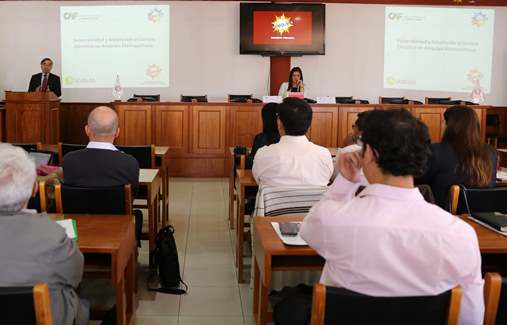Arequipa seeks to reduce its vulnerability in the face of climate change
The main challenges refer to providing a greater response capacity facing intense rains, and promote measures to guarantee the availability of water resources, among others, according to a study presented by the Regional Government of Arequipa carried out with CAF financing
Peru is a "particularly vulnerable" country, as it presents seven of the nine characteristics that rate the degree of vulnerability recognized by the United Nations Framework Convention on Climate Change (UNFCCC). Arequipa, the second most important city in Peru, already faces diverse threats originated in climate variability that may have significant impacts.
Considering the multiplicity of threats faced by this city in southern Peru, and the high vulnerability identified, the Regional Government of Arequipa presented the results of the study "Vulnerabilidad y Adaptación al Cambio Climático en Arequipa Metropolitana" (Vulnerability and Adaptation to Climate Change in Metropolitan Arequipa), financed by CAF, Development Bank of Latin America, and executed by the consulting company Libélula, Gestión en Cambio Climático y Comunicación (Libelula, Management in Climate Change and Communications).
The study states that the main problems faced by the city of Arequipa in the face of climate change are: Inadequate response capacity facing intense rain events; scarce availability of water resources; pressure on the Chili river due to urbanization, reducing the riverbed and the urban ecosystems; and potential islands of heat resulting from a deficit of green areas and loss of the countryside of Arequipa.
Threats and challenges
With respect to the four great problems of vulnerability to climate change found in the city of Arequipa, a portfolio of 12 adaptation measures was identified, which would reduce vulnerability in the city, implying an investment of over USD 230 million.
The study prioritizes the following measures: Infrastructure and information system in the face of floods for the city of Arequipa; recovery of the riverside forests of the Chili river in the city of Arequipa; urban parks in Cerro Colorado; and recovery of the Urban Ecosystem of the city.
These conclusions emerge from a vulnerability analysis carried out in the city, which includes environmental, economic, territorial, and social dimensions, and a sectorial analysis with a city approach in four prioritized areas: (i) Northeastern area of Cerro Colorado and Yura, (ii) Northeastern area of the districts of Cayma, Alto Selva Alegre, Miraflores, and Mariano Melgar, (iii) Districts of Arequipa and Jacobo Hunter, and (iv) Districts of Characato and Mollebaya. The two latter are the most vulnerable districts according to the variables included.
In the framework of the presentation of the results of the study, a space was created for the exchange of ideas regarding the implementation of the adaptation measures proposed for the city of Arequipa, headed by Yamila Osorio, governor of the region; Claudio Higa, Representative in charge of CAF's office in Peru; Adriana Carolina Cortés, Executive of CAF's Direction of Climate Change and The Environment; as well as representatives from the Provincial Major's Office; District Majors of the jurisdiction, representatives of governmental entities, and private sector, among others.
CAF's more recent content

CAF, ECLAC, IDB and PAHO Promote Sustainable Development in the G20
The Regional Organizations of the Americas congratulate Brazil on its successful G20 Presidency, highlighting its leadership on key issues such as poverty, governance, and climate change. They also reaffirm their commitment to actions that promote equity and development in the region.
Urgent Call for Action to Safeguard Caribbean SIDS at CAF Symposium
As the global community grapples with the escalating climate crisis, Caribbean Small Island Developing States (SIDS) are running out of time to secure critical investments and support needed to strengthen their economies and protect vulnerable communities from the intensifying impacts of climate change. With the window to take decisive action rapidly shrinking, CAF - Development Bank of Latin America and the Caribbean, in partnership with the Commonwealth Secretariat and the Antigua and Barbuda High Commission, brought together key stakeholders for a symposium in London to address the critical vulnerabilities Caribbean SIDS face.



